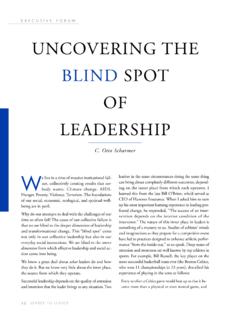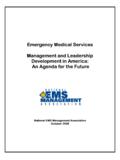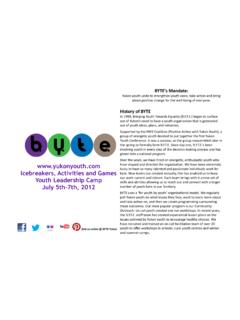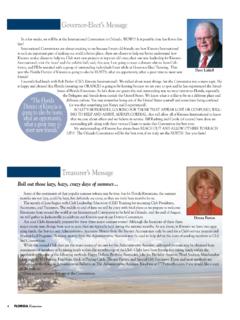Transcription of How to Design a Debrief Session - Camp High Rocks
1 1 F:\CAMP\STAFF\Orientation\Processing Information\How to Design a Debrief How to Design a Debriefing Session by Heidi Hammel Heidi Hammel wrote this article as a guide for The Quest Outdoor leadership Training Program at Bloomsburg State University in Pennsylvania Chances are you and I already agree that experiential education is a valuable form of education. I wouldn t be writing for an AEE journal and you probably wouldn t be reading one if we didn t both agree that there is tremendous potential for human development and growth in carefully designed, safely executed and thoughtfully processed experience. Since you are reading this particular article, chances are also good that you have some ideas and some questions about how you, as a leader or teacher can maximize that growth through thoughtful processing or debriefing. The primary purpose of debriefing is to allow participants to integrate their learning, thus gaining a sense of closure or completeness to their experience.
2 In order for participants to take what they have learned in an outdoor experience and use it effectively in their every day lives, they must think about it and interpret its meaning for themselves. As a leader, you can facilitate this process by: 1. Setting aside enough time to reflect on the experiences. 2. Asking the right questions. 3. Planning appropriate activities that will help participants reflect on their experiences. 4. Listening to the participants carefully. 5. Supporting each participant s unique learning. This debriefing guide provides some ideas for doing these things, but a word of caution is necessary: this is only a guide, not a set of rules to be followed exactly. The joy of designing a quality debriefing is that each one will be different, because each group you lead will be different. Stages of Learning In designing a debriefing, you are guiding people through a potentially complex learning process.
3 In order to do this effectively, it can be helpful to understand how people learn. How do we piece together information gained from experience, instruction or reflection? How do we get to the point where we can say, I learned ? One way to describe how people learn is Bloom s Taxonomy of Educational Objectives, which delineates six levels of learning: (For more information about applying this concept to experiential education, read How to Process Experience, Quinsland and Van Ginkel, JEE, Fall, 1984.) KNOWLEDGE (memory level)- remembering information by recognition or recall COMPREHENSION (understanding level) - interpreting or explaining knowledge or learning in a descriptive or literal way APPLICATION (simple usage level) - correct use of knowledge; , to solve rote problems or answer questions ANALYSIS (relationship level) - breaking knowledge down into component parts and detecting relationships between them; , identifying causes and motives SYNTHESIS (creative level) - putting together to form a whole; , to formulate a solution EVALUATION (opinion level) - making judgments about the value of ideas, solutions, events What does this mean?
4 It is simpler than it looks. At first, we are very concrete in our thinking about our experiences. We remember the events and their associated feeling ( Today we sweated it out on that hike. I remember feeling like it would never end! ) Once we have refreshed our concrete memories then we can look for patterns or relationships between recent and past events and feelings. ( I felt today like I ve felt before when there is an enormous unknown in front of me - tired, grouchy, excited all at once, I felt all those things because l didn t know what to expect. ) Only then can we move to more abstract thinking and consider what we have learned from an experience, how we might apply that learning in other situations and whether or not we like what we have learned. 2 F:\CAMP\STAFF\Orientation\Processing Information\How to Design a Debrief ( Maybe tomorrow l can look at the map in the morning, compare tomorrow s proposed distance with today's and then gauge my strength.)
5 I don t like feeling overwhelmed by not knowing what to expect, so I can inform myself and get a handle on what s coming up. ) Applying Stages of Learning The following is a chart to show how these stages of learning relate to the stages of debriefing. Learning Stage Debrief Stage Sample Questions & Activities Concrete Knowledge Comprehension Application Review/describe events feelings thoughts problems Questions: What did you do What happened How did you feel What did your group do Activities: Guided blind review I m proud that whip (can substitute happy, scared, excited, disappointed, pleased) Abstract Analysis Synthesis Evaluation * Values Clarification ** Playfair ** NCOBS: Field Manual Identify patterns Make comparisons Relate to daily life Propose solutions Examine values Questions: What was the highlight for you?
6 The most challenging? Do you see any patterns? Does this remind you of anything? Have you ever faced a similar challenge feeling? How? What did you do then? Have you learned anything here that you could use when that happens again? Have you learned anything about yourself through this experience? Activities: ** Human tableaux ** Pantomime highlight/challenge ** Place in the circle ** Self shield * Rogerian listening on a group issue * I learned that whip Choose & share two objects which represent self of before and now Multi-media sharing - imagine the highlight/ challenge; draw it; share drawing; write about the drawing; share the writing By recognizing the stages of learning as your groups go through them, you can Design or modify your Session to make it more effective. Different groups spend more or less time in each stage, so you must pay close attention. If you stay in the describing stage too long, you may notice people yawning or appearing bored or restless.
7 It is obviously time to move on to questions or activities that get people to make comparisons or identify patterns. On the other hand, a group that has not had enough time to review their experiences will often not be able to move on to the next stage. They will return to descriptions even though you have asked them to start comparing or looking for patterns. This means you ll need to give them more time and/or ways to finish that stage. A group that is still discovering patterns and making comparisons will not want to move on to thinking about how to apply their knowledge to their every day lives, nor will they want to describe how they felt about what they have learned. Your job is to sense when they are ready to move forward or when you are moving too quickly and need to slow down. 3 F:\CAMP\STAFF\Orientation\Processing Information\How to Design a Debrief Fine Tuning a Debriefing Once you understand that your debriefing Session needs to follow the stages of learning from concrete to analytic to abstract, you may be tempted to pull together a list of all the questions and activities you know and start designing.
8 Wait! There is more to consider. How do you know which activities will work? How do you know which questions to ask or how many or to whom? It is time to start fine-tuning. Assessment of Participants The first step is to assess the needs and abilities of your group, as individuals and as a group. Ask yourself: How involved is each person? How involved is the group? What kind of personal impact is this experience having on these people and the group? How self-aware are they? How well are they able to verbalize their feelings and thoughts? How comfortable are they sharing those feelings and thoughts with each other? For instance, how would you rate your group and the individuals in it on the scales of possible responses on the bottom of this page? Asking yourself these questions will help you select appropriate questions and activities for your group s debriefing. If your group has just spent an entertaining but uneventful day rock climbing, you would place a matter-of-fact, brief Session including questions and activities to review the day and a few questions or activities to allow them to reflect on the meaning of the day for themselves.
9 Since their level of involvement and the impact of the experiences was low, they will not need or want a lengthy soul-searching Session . On the other hand, after a fear-filled day on the Rocks , be prepared to allow time and support for people as they look back on that harrowing experience, relive some of the events and feeling from the safety of the solid ground, sort out their feelings and try to learn from them. Level of participant response Bored Actively resistant or passively noncommittal There, but just tentative, hesitant Totally focused Personal impact of the experience Ho hum A few pleasant experiences Oh WOW! Level of self-awareness I m not feeling anything I don t know what I m feeling I m not sure, but I think I I m feeling proud, sad, pleased, mad, frustrated, etc. Ability to verbalize feeling and thoughts Silence vague, mumbled words or unclear sentences, hard to understand specific, clear, descriptions or explanations Level of comfort with sharing Resistant Refusal to share Uncomfortable silence Chosen silence I m not ready to share that much Tentative sharing Spontaneous outpouring How do you know whether to use planned activities or just ask questions?
10 The amount and type of structure you use will depend on your participants needs as you have assessed them. The more unaware, inarticulate and uncomfortable your group is, the more structure you will need to provide. To ask a person who is just beginning to recognize her feelings to describe the difference in her feelings from the first to the last day may be asking the impossible. If she is just becoming aware of those feelings, she may not yet have words to describe them. She may well have forgotten the feelings from the first day, since she doesn t have words to pin them down. You may know she has felt many emotions from observing her face or listening to the tone of her voice. How can you help her recover those feelings? A structured activity or question may help her remember or label her feelings. After reviewing the events of the day you could start a whip going quickly around the circle using a specific feeling ( I was scared ) or ask When did you feel proud of yourself on this trip?





